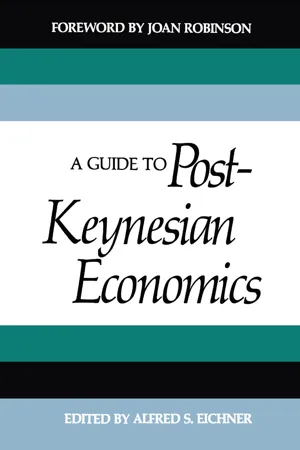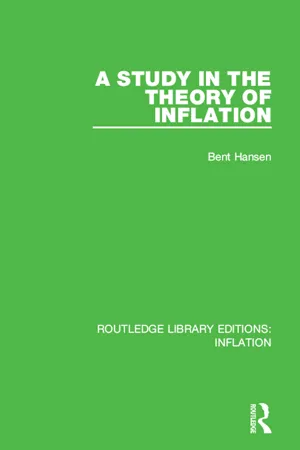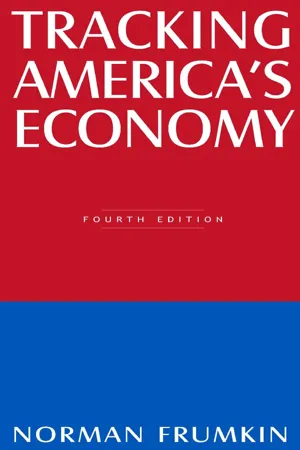Economics
Types of Inflation
The types of inflation include demand-pull inflation, which occurs when aggregate demand exceeds aggregate supply, leading to increased prices; cost-push inflation, caused by a decrease in aggregate supply due to increased production costs; and built-in inflation, resulting from expectations of future price increases leading to higher wages and prices. Each type has distinct causes and implications for the economy.
Written by Perlego with AI-assistance
Related key terms
Related key terms
1 of 4
Related key terms
1 of 3
5 Key excerpts on "Types of Inflation"
- eBook - ePub
- Krish Bhaskar, David F. Murray(Authors)
- 2015(Publication Date)
- Routledge(Publisher)
15Inflation1DOI: 10.4324/9781315677064-16Introduction
In this chapter we shall concentrate on one of the policy targets that we have mentioned already – inflation. At the risk of repeating Chapter 3 , we shall start with a discussion of the problems of defining inflation and then move on to consider the way in which the Keynesian and classical approaches to the subject may be fitted into the framework of demand pull and cost push inflation. This leads us to consider the simple Phillips curve trade-off between the rate of wage inflation and unemployment.In the later part of the chapter we shall take explicit account of the inter-relationship between wage and price changes and within the context of a two equation model consider the factors affecting price changes and those affecting wage changes. In this section we shall also appeal to the available empirical evidences as a means of assessing the merits of the various price change and wage change equations which have been suggested. Finally, we shall consider how an incomes policy operates in this two equation model.Inflation defined
Although everyone is sure that they know exactly what inflation is, it is remarkably difficult to define it unambiguously. The definitions which are commonly employed fall into two categories – those which concentrate on the effects of inflation and those which concentrate on the supposed causes. In the latter category come such definitions as ‘inflation exists when there is monetary expansion’ or ‘budget deficit financing’ or ‘a situation of excess demand’. Although it might appear that inflation defined in these ways leads directly to policy measures to curb it, as Johnson points out,2 inflation caused by deficit financing may not necessarily be removed by creating a balanced budget.Instead we shall use a definition which falls into the first category. Inflation we shall define as ‘a sustained upward trend in the general level of prices’. By implication it may be difficult to detect whether, at any given time, there is an upward trend in prices and whether this trend is sustained. In any case, not all price rises are truly inflationary; they may reflect the normal short term workings of the market place or improvements in product quality. The construction of price indices to show changes in the general level of prices is difficult not only for these reasons but also because of the need to attach weights to the commodities included in the index reflecting their relative importance which may, in any case, be continuously changing over time. - eBook - ePub
Judging Economic Policy
Selected Writings Of Gottfried Haberler
- Richard J Sweeney(Author)
- 2021(Publication Date)
- Routledge(Publisher)
I shall now discuss the different cases starting with (1) what is often called the “classical” case of demand inflation, and cost-or wage-push inflation, (2) “special supply-reducing factors,” and (3) international aspects (“imported inflation”). Actually the different factors usually operate concurrently. Demand and cost inflation are especially difficult to separate, but it is sometimes possible to find periods when the one or the other factor was dominant.Demand Inflation and Cost Inflation. There is agreement, shared by monetarists and anti-monetarists, such as James Tobin, that monetary restraint is the specific cure for demand inflation as distinguished from a cost- or wage-push inflation. That holds for an inflation which has its root in expanding bank credits to private business as well as for one which finances a government deficit. If the monetary authorities stand firm, a government deficit will drive up interest rates and “crowd out” private investment. Alternatively, a deficit can be eliminated by raising taxes or cutting government expenditures. As far as the effect on overall activity is concerned, there is probably not much difference between fighting a government-induced inflation by monetary policy (higher interest rates), raising taxes or cutting expenditures. But the sectoral impact (e.g., on the construction industry) and long-run effects on productivity growth will of course be very different depending partly on which taxes are raised and which expenditures are cut.4 It is often assumed that the transition from an inflationary to a non-inflationary (or less inflationary) situation can be accomplished without side effects on overall activity if it is brought about by fiscal rather than by monetary measures.5 I cannot see the difference--apart from the different sectoral or long-run impact.But how do we distinguish a demand-pull inflation from a cost-push inflation, conceptually and in reality? The standard phrase which has been used again and again by economists and policy makers in the course of the current inflation is that when “excess demand” has been “squeezed out,” but prices continue to rise, demand inflation has been transformed into a cost inflation. But this is a very misleading expression. What is “excess demand?” Whenever the price level rises, aggregate demand rises faster than aggregate supply. In that sense demand is excessive whenever there is a rise in the price level. A better description is the Keynesian term “profit inflation,” used in The Treatise on Money. - eBook - ePub
- Alfred S. Eichner(Author)
- 2023(Publication Date)
- Routledge(Publisher)
While economic crises always produce unemployment, in recent years they have also been accompanied by inflation. The recent world inflation is widely regarded as having begun in the United States as a response to excess demand growing out of deficit-financed war expenditures for Vietnam. This inflation was propelled onward and outward by synchronous booms throughout the capitalist countries which greatly augmented aggregate demand for world resources. The prolonged boom of the 1960s and the demand-pull inflation that it created in turn produced cost-push pressures which have persisted into the world recession of the 1970s, and account for the current state of stagflation. Inflation now coexists with unemployment mainly because the working classes have gained and retained sufficient political and economic strength to battle more evenly with capital over shares of the national income.The causes of inflation
The contemporary orthodox division of economics into two parts, microeconomics and macroeconomics, grew out of the earlier Marshallian division of the subject into the theory of value and the theory of money. In microeconomics, supply and demand interact to determine relative prices through the application of either Marshallian partial-equilibrium or Walrasian general-equilibrium analysis. Modern macroeconomics, in the version that has come to be identified as the “neoclassical synthesis,” lumps together the old quantity theory of money, which determines the level of absolute prices, with a bastardized version of Keynes centering on how price rigidities may prevent the economy from actually reaching full-employment equilibrium.For modern post-Keynesians, in contrast, the rate of inflation is determined primarily by the rate of increase of nominal money wages relative to labor productivity. Over wide sectors of the economy, prices are largely cost-determined, based on a mark-up over unit labor costs. (The main exceptions are the agricultural and raw materials sectors where prices are still jointly determined by supply and demand.) This mark-up of prices over unit labor costs will be constant over time for the economy as a whole so long as the capital and labor shares of national income are constant, irrespective of the assumptions governing price-setting behavior. So long as factor shares are constant, a constant mark-up will result even if all markets are assumed perfectly competitive and the neoclassical assumption made that all factors are paid the value of their marginal products. A rise in raw material prices, a rise in the share of national income going to government, and an increase in the rate of investment expenditures will all tend to lead to a higher mark-up, reducing real wages by driving a larger wedge between unit wage costs and prices. - eBook - ePub
- Bent Hansen(Author)
- 2016(Publication Date)
- Routledge(Publisher)
CHAPTER I GENERAL SURVEY OF THE CHARACTERISTICS OF INFLATION1. Two main treatments of the theory of inflationOn considering the history of theories of inflation, it is possible to distinguish two main treatments, of which the one seems to have had its origin far back in the past, while the other is only half a century old.The first of these is based on some form or other of the quantity theory of money, and regards an increase in the quantity of money as the cause and characteristic of inflation. According to this way of thinking, if the quantity of money increases, prices rise and inflation exists as a consequence—other things being equal. Thus inflation is regarded as actually identical with an increase in the quantity of money. Undue concentration upon the changes in the quantity of money often leads to peculiar results. For example if the state finances public works with central bank credits during a severe depression, this might be called inflation, as was done sometimes during the thirties. From the same point of view, it has also been argued that during the German hyper-inflation in 1923, there was in reality no inflation at all.1 These are just a couple of the strangest examples of what this approach to inflation theory may lead to. But even apart from that, it is generally agreed that this use of the quantity of money (in one sense or another) as the starting-point for the study of inflation has not shown itself to be very appropriate.2Even if this approach is very commonly taken, in economic journalism and in so-called “common-sense” argument, the discussion in more recent years has consistently stressed other aspects of inflation, and that will be done in the present study also. This does not imply a denial that changes in the quantity of money may be of important causal significance in the course of inflation: the period since the second World War has witnessed several interesting monetary reforms, which seem to have been effective to a certain degree in combating inflation, although the interrelationships have certainly been rather too complicated to be explained by a simple quantity theory of money. What matters is that we will try to find a more general approach to the theory of inflation, in which the effects of changes in the quantity of money can be incorporated if necessary as one among many other (probably more important) features of significance in the process of inflation. - eBook - ePub
- Norman Frumkin(Author)
- 2015(Publication Date)
- Routledge(Publisher)
assets .DEFINITIONS
Inflation is the general term given to a rise in overall prices for the total of all goods and services in the economy on an ongoing monthly, quarterly, and annual basis. Deflation represents a decline in overall prices of goods and services. Zero inflation occurs when there is no change in overall prices. It results from offsetting price increases and decreases among the individual items.There are varying inflationary gradations that both affect and are affected by the economy quite differently. Examples of these gradations are: core inflation, accelerating inflation vs. disinflation, creeping inflation vs. hyperinflation, and tolerable inflation.Core inflation is an objective measure of price change that excludes changes in energy and food prices. It is sometimes called the “underlying rate of inflation” because it abstracts from temporary price fluctuations in food and energy that may have nothing to do with long-term price pressures in the economy. Food prices fluctuate in large part due to changes in the weather associated with rainfall and frosts, as well as with natural disasters of floods and hurricanes. These physical elements directly affect plantings and harvests of grains, fruits, and vegetables, which in tum affect cattle prices through feed grain prices, with larger harvests tending to lower prices and smaller harvests tending to raise prices. Energy prices fluctuate as the discipline of member nations in maintaining cartel prices among the Organization of Petroleum Exporting Countries (OPEC) strengthens and weakens. When the nations tend to regulate their oil production in line with OPEC guidelines, the effect is to bolster prices, and when they do not follow the production guidelines, the effect is to weaken prices. Daniel Yergin illuminates the political problems of maintaining discipline among the OPEC nations in adhering to agreed-on country output quotas.1
Index pages curate the most relevant extracts from our library of academic textbooks. They’ve been created using an in-house natural language model (NLM), each adding context and meaning to key research topics.
Explore more topic indexes
Explore more topic indexes
1 of 6
Explore more topic indexes
1 of 4




